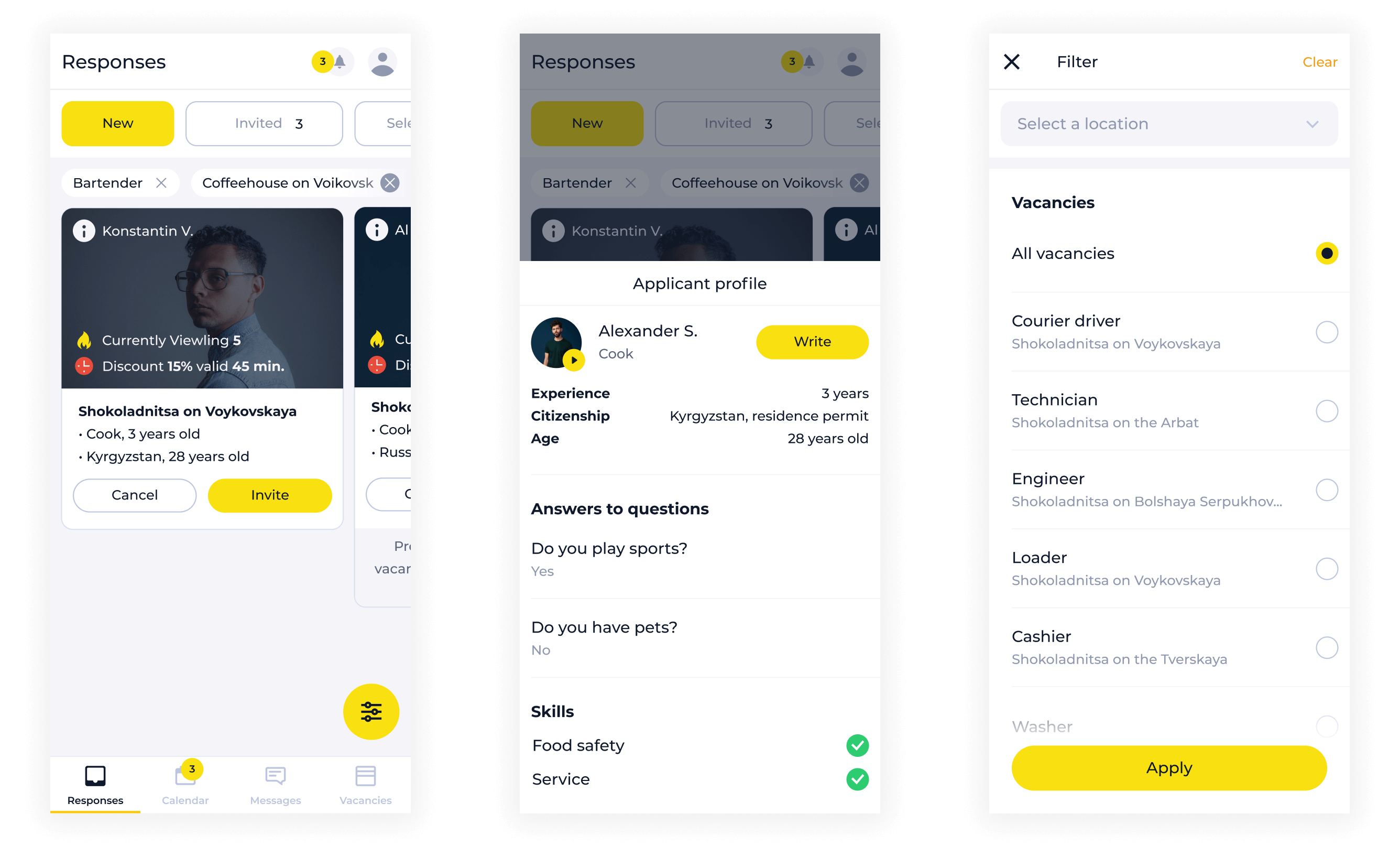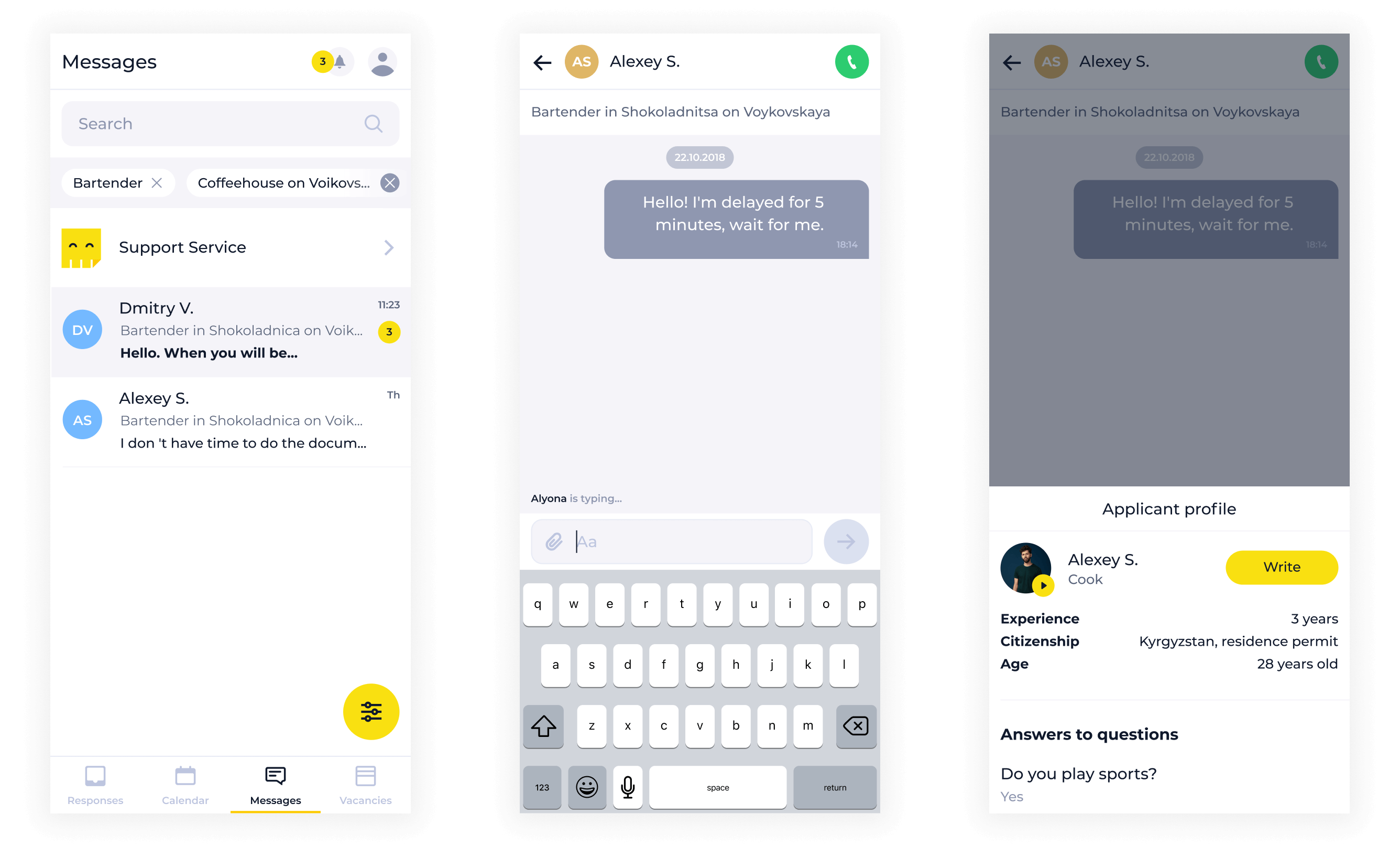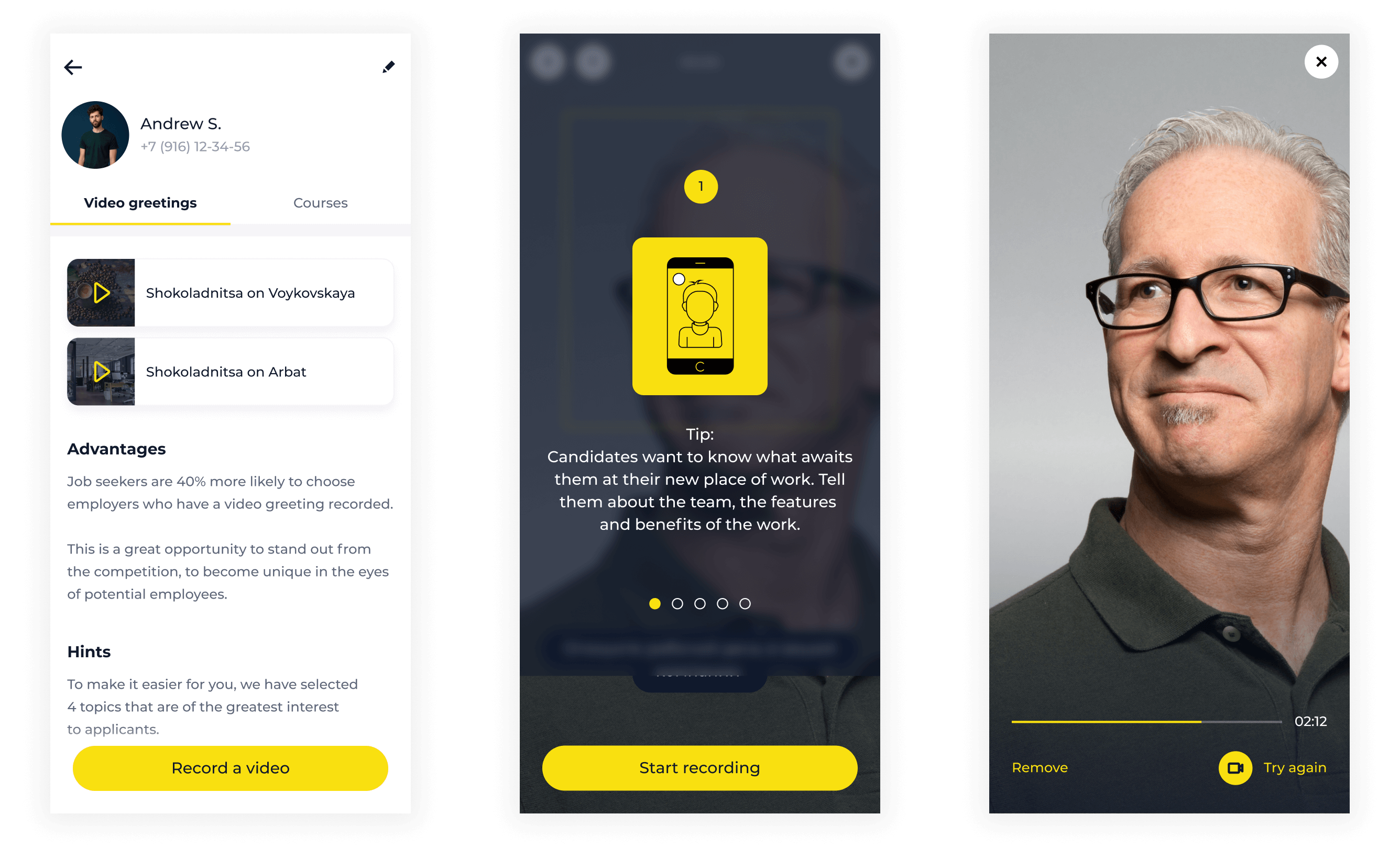Discovery
We had conversations with the company's stakeholders and managers representing the interests of YAYA's major clients. They shared with us the business concept, market dynamics, limitations, and goals.
After that, we studied user feedback and conducted a series of interviews with them to understand how they previously addressed HR challenges, how they used the YAYA platform, and the difficulties they encountered during its usage.
We also created a profile of potential candidates for our clients' vacancies. Fortunately, during that time, an office opened in the center of Moscow where anyone interested could come, learn about job openings, and apply for one of them by recording a video resume. This allowed us to significantly increase the number of registrations on the YAYA HR platform and gain loyal users who trust the company. We spoke with some of these individuals. Based on their responses, we learned that:
- Many of them work in the service industry, where salaries are low and demands are high.
- They often quit their jobs and quickly find new ones in similar companies and positions due to low wages and a lack of savings.
"Absolute time-saver!"
YAYA has been great for our Junior level vacancies, where typically we received 1000+ applications. With these types of roles, we prefer to look at aptitude, personality, and culture add to Coffee House and curiosity/eagerness to learn. Without YAYA, we would have spent countless hours on introductory interviews to do this, which is not the best use of our time. I've used competitors in the past, but have no need or desire to go elsewhere given the ROI we get via YAYA. We have recommended YAYA to some of our partners who struggle with junior hires currently.”
– Russian representer @ Coffee House
UX Design
Main parts of HR platform
- The web and mobile application for the HR department includes features such as company information, branch management, creation and description of vacancies, evaluation of candidate responses, and scheduling interviews.
- The mobile application for candidates allows them to find jobs in their desired city district without having to go through numerous interviews. They can quickly apply by submitting video resumes. Additionally, candidates can undergo employer-provided training in the form of tests to enhance their qualifications.
Define & refine
To understand how everything works, we decided to visualize the project documentation to get a holistic view.
- We started with the Customer Journey Map (CJM), which visualizes the customer's journey from the moment they search for a product or service until they make a purchase. This helped us understand the overall customer experience.
- Next, we visualized the current User Flow, which is a diagram of blocks and connections within the application. This allowed us to create a Customer Journey Map and an information architecture.
- Finally, we created a table with the functions that have already been implemented and those awaiting addition, specifying their priorities, constraints, and user stories. This helped us prioritize and track the progress of the features.
Competitor analysis
We selected digital products that have functionality crucial to the YAYA HR platform in order to study their implementation. During the process, we documented the most interesting solutions and added them to a moodboard, which later became a source of inspiration for our designers.
Additionally, we conducted an analysis of user feedback on these products, noting the most positive and negative aspects to take into account in our design.
UI design for a mobile application for HR managers
Next, we will examine one of the products of the HR platform, specifically the mobile application for HR managers. This will be sufficient to understand the logic of design solutions as well as the level of implementation.
Initially, we planned to work in two-week sprints. However, we naturally transitioned to one-week sprints.
- On Monday, the product manager would describe the design task to the designer for implementing one key feature and answer any questions that arose.
- On Tuesday, the designer would present 2-3 design variations to the team. These concepts had low detail to quickly gather feedback. Based on these concepts, a single solution would be agreed upon, and the designer would proceed with it.
- By Thursday, the final version of the design would be ready. Based on minor feedback, final adjustments would be made either on the same day or on Friday.
If the designer was unable to meet the deadlines, they would complete the work on Monday.
The challenges
Translation: The mobile application was initially built based on a chatbot. This technology was trendy at the time, but its capabilities were severely limited. The chatbot operated in a "Question-Answer" format with multiple-choice answers, and so on indefinitely. When there are few functions, this approach is quick and easy. However, as the mobile application rapidly grew and new features were added, it became impractical to implement them within the constraints of the chatbot's logic.
A similar problem arose with Ruby on Rails, the framework that developers used to create a single mobile application for both iOS and Android. Unfortunately, implementing non-standard functionality with it was extremely challenging. The company spent a lot of money before giving up and deciding to develop separate native applications for each platform.
Navigation
We have identified four main sections:
- Responses: This is where video resumes from applicants, along with additional textual information, are received and reviewed to make decisions on whether to reject or invite for an interview.
- Calendar: In this section, managers can set their availability, and it displays time slots assigned for interviews.
- Messages: Managers and candidates whose video resumes have been approved can communicate via text or video.
- Vacancies: Here, new job vacancies can be created, associated with company branches, enabled or disabled as needed, and the number of applications for specific branch vacancies can be viewed.
The tabs are arranged from left to right based on their frequency of use. This also reflects the logical workflow with the candidates. First, the application needs to be approved, then interviews are scheduled, and finally, the details for starting work are coordinated. The "Job Listings" tab is placed last because the information there changes less frequently.
The use of a small number of sections allowed us to employ a UI component called Tabs. It is positioned at the bottom of the screen, making it convenient to switch between tabs without the need for extensive finger movement.
An alternative such as a hamburger menu hides the navigation and creates usability issues. We have only kept the Profile and Notifications icons in the top panel because they are less frequently used than the four main tabs and are not logically connected to them.
Responses
Candidates' responses appear in real time. They can be filtered by professions and company branches. Five columns are used for sorting: new, invited, selected, hired, refused. This way, the manager focuses on the main task, which is evaluating candidates' responses.

Calendar
There are two viewing modes: weekly and daily, with information about the days and hours scheduled for interviews. In the editing mode, you can mark available slots on the calendar for conducting interviews. Despite the use of non-standard solutions, the calendar is intuitive, and all the information is visible and easy to work with.

Messages
The contacts list displays candidates invited for interviews, as well as the YAYA support team for questions and suggestions. Contacts can be filtered by professions and locations. In the chat, by clicking on a user's avatar, you can see their profile. If desired, you can initiate a voice call by clicking on the phone icon.

Vacancies
To create a new job vacancy, you need to select one of the predefined profession templates available in the web application. You can make any necessary modifications to the template and publish it as a new vacancy. Later, if needed, you can enable or disable the vacancy as required.

Profile
The manager can record a welcome video for candidates who have responded to the company's job vacancies. This practice helps increase the number of responses as it distinguishes the company from its competitors. In the profile, there are also educational video courses available to develop managers' skills. These courses aim to enhance their capabilities in recruitment and HR management.

Conclusion
We systematized design approaches in the YAYA HR platform by creating a unified design system and analyzing user needs. We received many positive comments regarding the redesign, highlighting its ease of use. New clients and users were able to quickly understand the functionality provided by the HR platform, resulting in a significant reduction in the learning period required to use it effectively. This led to an increase in YAYA subscription sales and the number of video resumes from job seekers.